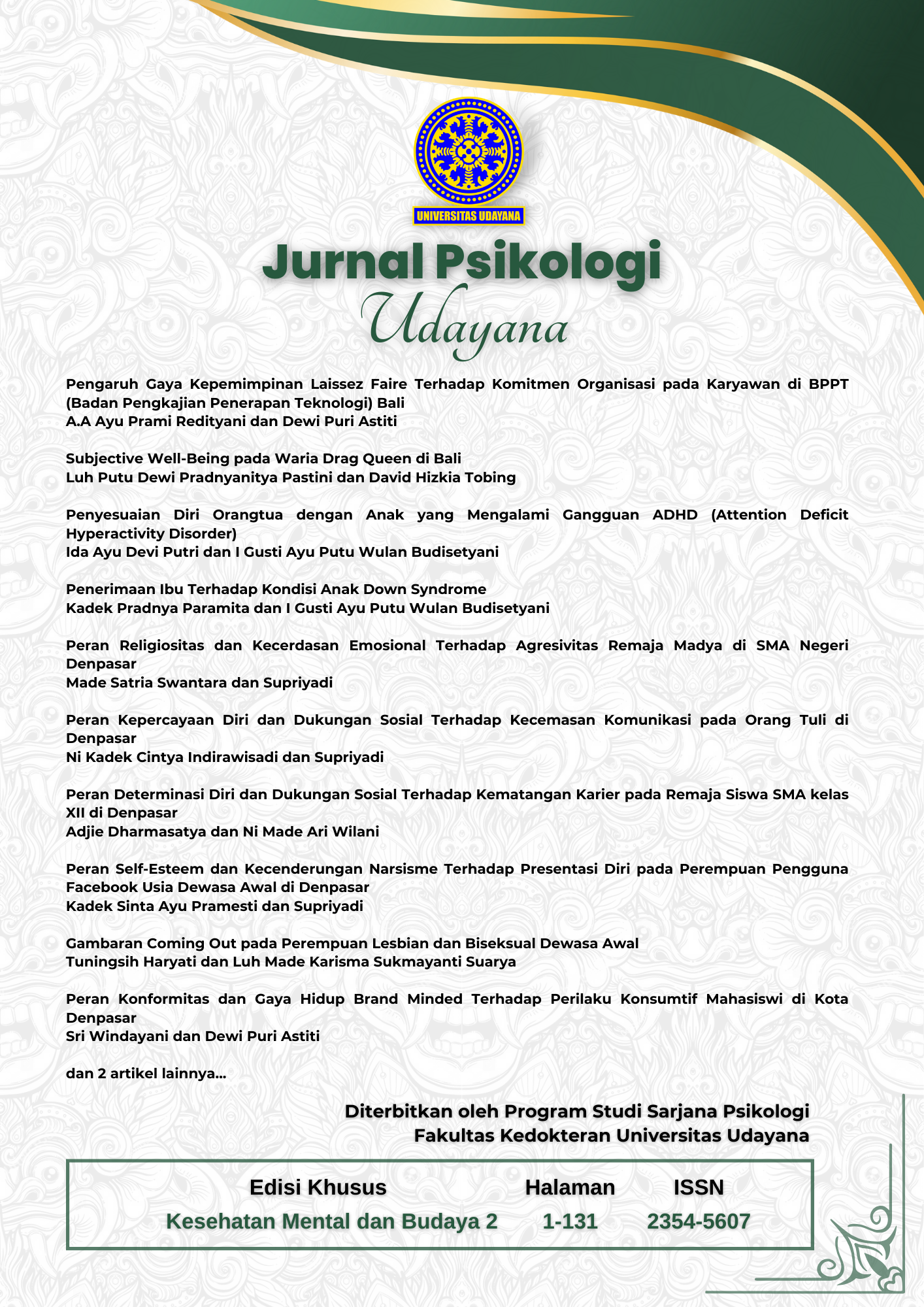Peran intensitas komunikasi di Instagram dan perbandingan sosial terhadap ketidakpuasan tubuh pada perempuan remaja akhir
Abstract
Ketidakpuasan tubuh merupakan pikiran dan perasaan tidak puas akan kondisi tubuh individu. Hal ini banyak ditemui di kalangan remaja perempuan karena adanya beragam perubahan, termasuk fisik. Walaupun usianya akan memasuki usia dewasa, perempuan remaja akhir tetap memiliki ketidakpuasan tubuh yang cukup tinggi, salah satunya karena Instagram. Popularitasnya di kalangan remaja membuat banyak individu memilih untuk berkomunikasi di media sosial tersebut dengan beragam isu, seperti adanya risiko kesehatan dan munculnya perbandingan sosial. Perbandingan sosial dilakukan karena motivasi individu untuk mengevaluasi diri melalui atribut yang dimiliki dengan individu lainnya. Perbandingan sosial dapat ditemui ketika remaja menggunakan Instagram, yang dapat mengarah pada ketidakpuasan tubuh. Penelitian ini merupakan penelitian kuantitatif untuk mengetahui peran intensitas komunikasi di Instagram terhadap ketidakpuasan tubuh pada perempuan remaja akhir dengan perbandingan sosial sebagai variabel moderasi. Pengambilan sampel dilakukan dengan teknik cluster sampling. Subjek penelitian ini adalah 110 perempuan usia 17-22 tahun yang berdomisili di Denpasar. Alat ukur yang digunakan adalah Skala Ketidakpuasan Tubuh, Skala Perbandingan Sosial, dan Skala Intensitas Komunikasi di Instagram. Hasil uji Moderated Regression Analysis (MRA) menunjukkan nilai koefisien tidak terstandarisasi sebesar -2,635 dengan signifikansi 0,003, yang berarti intensitas komunikasi di Instagram berperan terhadap ketidakpuasan tubuh, serta nilai koefisien tidak terstandarisasi moderasi perbandingan sosial sebesar 0,026 dengan signifikansi 0,005, yang berarti perbandingan sosial berperan dalam memperkuat hubungan antara intensitas komunikasi di Instagram dengan ketidakpuasan tubuh. Koefisien determinasi (R2) dalam penelitian ini sebesar 0,436, yang berarti intensitas komunikasi di Instagram dan perbandingan sosial berperan sebesar 43,6% pada ketidakpuasan tubuh.
Downloads
References
APA (2002). Developing adolescents: A reference for professionals. Washington, DC: American Psychological Society.
Azwar, S. (2016). Reliabilitas dan validitas (Edisi 4). Yogyakarta:
Pustaka Pelajar.
Baron, R. A., & Branscombe, N. R. (2011). Social Psychology (13th Ed). Boston: Pearson Education, Inc.
Brown, Z., & Tiggemann, M. (2016). Attractive celebrity and peer images on Instagram: Effect on women’s mood and body image. Body Image, 19, 37–43. doi:10.1016/j.bodyim.2016.08.007
Bunk, B. P., Collins, R. L., Taylor, S. E., VanYperen, N. W., & Dakof, G. A. (1990). The affective consequences of social comparison: either direction has its ups and downs. Journal of Personality and Social Psychology, 59(6), 1238–1249.
Cash, T., F., & Pruzinsky, T. (2002). Body image: A handbook of theory, research and clinical practice. London: Guilford Press.
Charbonneau, A. M., Mezulis, A. H., Hyde, J. S. (2009). Stress and emotional reactivity as explanations for gender differences in adolescents’ depressive symptoms. Journal Youth Adolescence. 38 (8): 1050-1058.
Chaudhari, B., Tewari, A., Vanka, J., Kumar, S., & Saldanha, D. (2017). The Relationship of Eating Disorders Risk with Body Mass Index, Body Image and Self-Esteem among Medical Students. Annals of Medical and Health Sciences Research, 7(3).
Chen, L. J., Fox, K. R., Haase, A. M. (2008). Body shape dissatisfaction and obesity among Taiwanese adolescents. Asia Pacific journal of clinical nutrition, 17 (3), 147-60.
Cohen, R., Fardouly, J., Newton-John, T., Slater, A. (2019). #BoPo on Instagram: An experimental investigation of the effects of viewing body positive content on young women’s mood and body image. New Media & Society. 1-19
Collins, R. L. (1996). For better or worse: The impact of upward social comparison on self- evaluations. Psychological Bulletin, 119(1), 51–69.
Davidson, H., Cave, K. R. & Sellner, D. (2000). Differences in visual attention and task interference between males and
females reflect differences in brain laterality.
Neuropsychologia 38(4), 508-519.
de Vries, D.A., Peter, J., de Graaf, H., Nikken, P. (2016). Adolescents’ social network site use, peer appearance-related feedback, and body dissatisfaction: testing a mediation model. Journal of Youth and Adolescence. 2016;45(1):211– 224.
Devito, J. A. (2009). Human Communication: The Basic Course.
(11th Ed.) Boston: Allyn and Bacon.
Drewnowski, A. & Yee, D. K. (1987). Men and body image: Are males satisfied with their body weight? Psychology Med, 40, 626-634.
Fardouly, J, Willberger, B.K., Vartanian, L.R. (2017). Instagram Use and Young Women’s Body Image Concerns and Self-Objectification: Testing Mediational Pathways. Australia: Media & Society.
Fardouly, J., Diedrichs, P. C., Vartanian, L. R., & Halliwell, E. (2015). Social comparisons on social media: The impact of Facebook on young women's body image concerns and mood. Body image, 13, 38-45.
Festinger, L. (1954). A theory of social comparison processes. New York: Sage Social Science Collection.
Furnham, A., & Calnan, A. (1998). Eating disturbance, self-esteem, reasons for exercising and body weight dissatisfaction in adolescent males. European Eating Disorders Review, 6, 58-72.
Glasser, W. (1969). Schools without failure. New York: Harper and Row.
Ghozali, I. (2013). Aplikasi analisis multivariate dengan program IBM SPSS 23 (Edisi 8). Semarang: Badan Penerbit Universitas Diponegoro.
Grabe, S., Ward, L. M., & Hyde, J. S. (2008). The role of the media in body image concerns among women: A meta-analysis of experimental and correlational studies. Psychological Bulletin, 134(3), 460-476. http://dx.doi.org/10.1037/00332909.134.3.460
Gunarsa, S. D., & Gunarsa, Y. S. D. (2001) Psikologi perkembangan anak dan remaja. Jakarta: BPK Gunung Mulia.
Gurian, M., and Stevens, K. (2004). With boys and girls in mind. Educational Leadership, 62(3), 21-26.
Guyer, J., & Vaughan-Johnston, T. (2018). Upward and downward social comparisons: A brief historical overview. Madrid: Tidak dipublikasikan.
Hene, Y. (2015). The Psychological Impacts of Instagram on Young South African Adults SelfEsteem. Naskah tidak dipublikasi.
Hurlock, E. B. (1980). Psikologi Perkembangan: Suatu pendekatan sepanjang rentang kehidupan (edisi 5). Jakarta: Erlangga.
Jausovec, N. & Jausovec, K. (2005). Sex differences in brain activity related to general and emotional intelligence. Brain and Cognition, 59(3), 277-286.
Jones, D. C. (2001). Social comparison and body image: attractiveness comparison to models and peers among adolescent girls and boys. Sex roles, 45(9), 646-661.
Killgore, W., Oki, M. & Yurgelin-Todd, D. (2001). Sex-specific developmental changes in amygdala responses to affective faces. NeuroReport, 12, 427-433.
Kleemans, M., Daalmans, S., Carbaat, I., Anschütz, D. Picture perfect: the direct effect of manipulated Instagram photos on body image in adolescent girls. Media Psychology. 2018;21(1):93–110.
Klimstra, T.A., Hale, W. W., Raaijmakers, Q. A., Branje, S. J., & Meeus, W. H. (2009). Identity formation in adolescence: change or stability?. Journal of youth and adolescence, 39(2), 150-62.
Krasnova, H., Wenninger, H., Widjaja, T., & Buxmann, P. (2013). Envy on Facebook: A hidden threat to users’ life satisfaction? Paper presented to the 11th International Conference on Wirtschaftsinformatik, Lepzig, Germany.
Lawler, M., & Nixon, E. (2011). Body dissatisfaction among adolescent boys and girls: the effects of body mass, peer appearance culture and internalization of appearance ideals. Journal of youth and adolescence, 40 1, 59-71.
Lim, S., Han, C. E., Uhlhaas, P. J., and Kaiser, M. (2015) Preferential detachment during human brain development: age- and sex-specific structural connectivity in Diffusion Tensor Imaging (DTI) data. Cerebral Cortex, 25(6), pp. 1477-1489.
Mappiare, A. (1982). Psikologi Remaja. Surabaya: Usaha Nasional.
Maurilla, T. (2019). Studi pendahuluan: Peran Intensitas Komunikasi di Media Sosial Instagram dan Perbandingan Sosial terhadap Ketidakpuasan Tubuh pada Perempuan Remaja Akhir. Denpasar: Tidak dipublikasikan.
McCabe, M. P., Ricciardelli, L. A., & Finemore, J. (2002). The role of puberty, media and popularity with peers on strategies to increase weight, decrease weight and increase muscle tone among adolescent boys and girls. Journal of Psychosomatic Research, 52,145-154.
Miranda MLJ, Godeli MRCS. (2003). Música, atividade física e bem-estar psicológico em idosos. R. bras. Ci. Mov; 11(4):87-90.
Neumark-Sztainer, D., Paxton, S. J., Hannan, P. J., Haines, J., Story, M. (2006). Does body satisfaction matter? Five-year longitudinal associations between body satisfaction and health behaviors in adolescent females and males. Journal of Adolescent Health, 39, 244-251.
Ogden, J. (2002). Psychology of eating: from healthy to disordered behavior. USA: The Blackwell Publishing.
Pertiwi, W. K. (2018). Riset Ungkap Pola Pemakaian Medsos Orang Indonesia. Retrieved February 10, 2019 from https://tekno.kompas.com/read/2018/03/01/10340027/risetun gkap-pola-pemakaian-medsos-orang-indonesia
Pin, E. (2016). Pinterest, Snapchat and Instagram: Why visual-based social media is growing so much faster than Facebook and Twitter. Retrieved February 26, 2019 from https://www.fipp.com/news/features/visual-based-social-media-growing-fast
Pollard, C. (2017). Why Visual Content Is a Social Media Secret Weapon. Retrieved February 26, 2019 from https://www.huffingtonpost.com/catriona-pollard/why-visual-content-isa-s_b_7261876.html
Putnam, R. D. (2000). Bowling alone: The collapse and revival of American community. New York: Simon & Schuster.
R, Jeko. I. (2016, January 15). Wanita Lebih Doyan Main Instagram Ketimbang Pria. Liputan 6. Retrieved from https://www.liputan6.com/tekno/read/2412338/wanita-lebih-doyanmain-instagram-ketimbang-pria
Rancourt, D., Leahey, T. M., LaRose, J. G., & Crowther, J. H. (2015). Effects of weightfocused social comparisons on diet and activity outcomes in overweight and obese young women. Obesity, 23(1), 85.
Rice, F. P. (2004). The adolescent: development, relationship and culture. Ohio: Ohio Wesleyan University.
Santos, E. M. C., Tassitano, R. M. T., do Nascimento, W. M. F., Petribu, M. de Moraes V., Cabral, P. C. (2011). Body satisfaction and associated factors among high school students. Rev Paul Pediatr, 29(2), 214-23.
Sari, I. A. W. P., & Suarya, L. M. K. S. (2018). Hubungan antara Social Comparison dan Harga Diri terhadap Citra Tubuh pada Remaja Perempuan. Jurnal Psikologi Udayana, 5(2), 265-277.
Sarwono. (2003). Psikologi Remaja. Jakarta: PT. Raja Gravido Persada.
Sax, L. (2006). Six degrees of separation: What teachers need to know about the emerging science of sex differences. Educational Horizons, 84(3), 190-200.
Sugiyono. (2017). Metode Penelitian Kuantitatif, Kualitatif, dan R&D. Bandung: Alfabeta.
Tamayo A, Campos APM, Matos DR, Mendes GR, Santos JB, Carvalho NT. A influência da atividade física regular sobre o autoconceito. Estudos de Psicologia 2001; 6(2):157165
Tantleff-Dunn, S. & Gokee, J.L. (2002). Interpersonal influences on body image development. In T.F. Cash & T. Pruzinsky (Eds.), Body image: A handbook of theory, research, and clinical practice (pp.108-116). New York: Guilford Press.
Taylor, S., Peplau, L. Sears, D. (2009). Psikologi sosial. Jakarta: Kencana Pernada Media Group.
Thompson, J. K., Heinberg, L. J., Altabe, M., & Tantleff-Dunn, S. (1999). Exacting beauty: theory, assessment, and treatment of body image disturbance.Washington, DC: American Psychological Association.
Verduyn, P., Ybarra, O., Résibois, M., Jonides, J., & Kross, E. (2017). Do social network sites enhance or undermine subjective well-being? A critical review. Social Issues and Policy Review, 11(1), 274—302.
Wertheim, E. H., & Paxton, S. J. (2011). Body image development in adolescent girls. In T. F. Cash & L. Smolak (Eds.), Body image: A handbook of science, practice, and prevention (pp. 76-84). New York, NY, US: Guilford Press.
Wiranatha, D. F., & Supriyadi. (2015). Hubungan antara citra tubuh dengan kepercayaan diri pada remaja pelajar puteri di Kota Denpasar. Naskah tidak dipublikasikan. Fakultas Kedokteran Program Studi Psikologi, Universitas Udayana, Bali.
Wood-Barcalow, N.L., Tylka, T.L., Augustus-Horvath, C.L. (2010). ―But I Like My Bodyǁ: Positive body image characteristics and a holistic model for young-adult women. Body Image, 106-116. doi:10.1016/j.bodyim.2010.01.001
Worthy, P. (2018). Top Instagram Demographics That Matter to Social Media Marketers. Retrieved March 13, 2019 from https://blog.hootsuite.com/instagram-demographics/
Yang, C. (2016). Instagram Use, Loneliness, and Social Comparison Orientation: Interact and Browse on Social Media, But Don’t Compare. Cyberpsychology, Behavior, and Social Networking, 19(12), 703-708.
Yanover, T., & Thompson, J. K. (2008). Eating problems, body image disturbances, and academic achievement: Preliminary evaluation of the eating and body image disturbances academic interference scale. International Journal of Eating Disorders, 41(2). 184–187.
Yeo, S. L., Ang, R. P., Chong, W. H., Huan, V. S. (2007). Gender Differences in Adolescent Concerns and Emotional Well-Being: Perceptions of Singaporean Adolescent Student. The Journal of Genetic Psychology, 168(1), 63-80.
Zuo (A), (2014): Measuring Up: Social Comparisons on Facebook and Contributions to SelfEsteem and Mental Health. [Online]. Available from http://www.ebscohost.com/.
Authors who publish with this journal agree to the following terms:
- Authors retain copyright and grant the journal right of first publication with the work simultaneously licensed under a Creative Commons Attribution-ShareAlike 4.0 International License that allows others to share the work with an acknowledgement of the works authorship and initial publication in this journal.
- Authors are able to enter into separate, additional contractual arrangements for the non-exclusive distribution of the journals published version of the work (e.g., post it to an institutional repository or publish it in a book), with an acknowledgement of its initial publication in this journal.
- Authors are permitted and encouraged to post their work online (e.g., in institutional repositories or on their website) prior to and during the submission process, as it can lead to productive exchanges, as well as earlier and greater citation of published work (See The Effect of Open Access).













